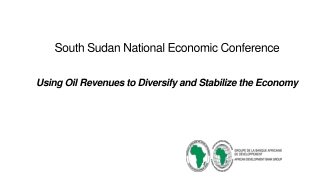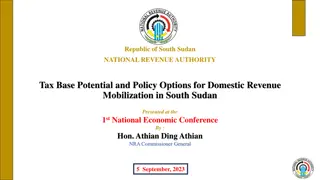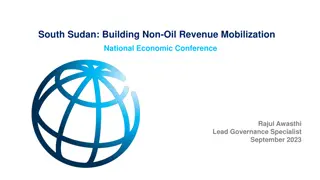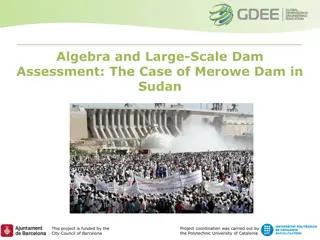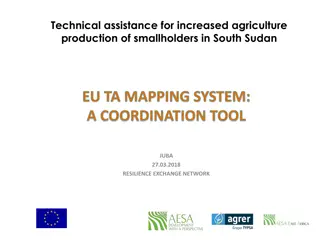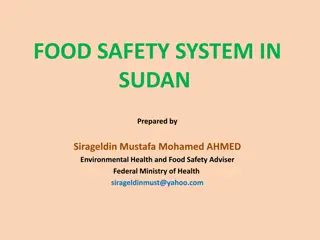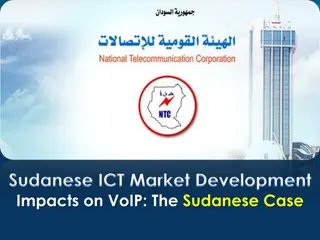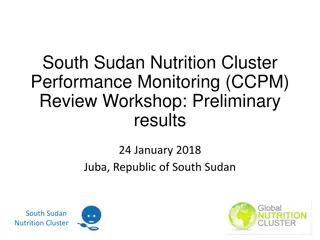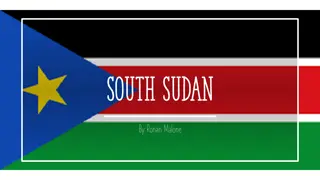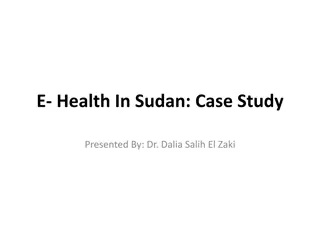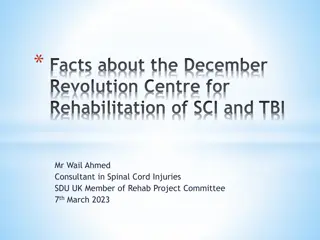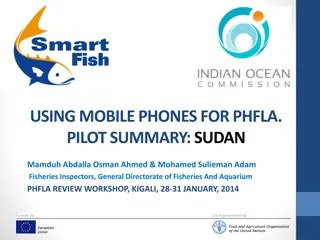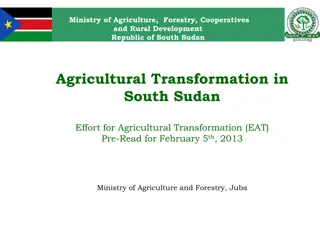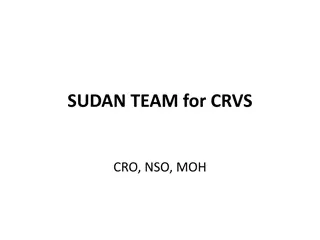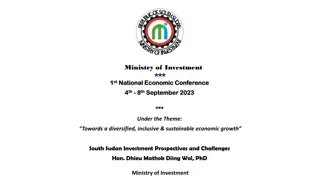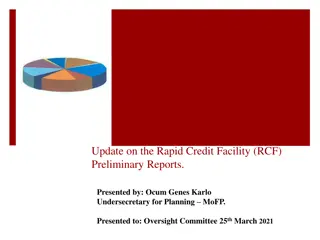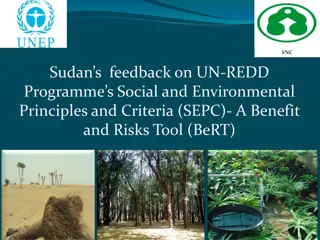Enhancing Agriculture and Economic Integration in South Sudan
South Sudan, a land-linked country, is exploring strategies to revitalize its agriculture sector and promote local economic integration. With a focus on agroecology, the presentation outlines the country's agricultural landscape, challenges, and potential outcomes. The aim is to generate discussions on sub-national and national food systems for sustainable development.
Download Presentation

Please find below an Image/Link to download the presentation.
The content on the website is provided AS IS for your information and personal use only. It may not be sold, licensed, or shared on other websites without obtaining consent from the author. Download presentation by click this link. If you encounter any issues during the download, it is possible that the publisher has removed the file from their server.
E N D
Presentation Transcript
Revitalizing Agriculture and Generating Local Economic Integration: The South Sudan Food System and the Outcomes of Sub-National and the South Sudan Sub-National and National Food Systems Dialogue First National Economic Conference,04-08 September,2023,Freedom Hall/Radisson Blu,Juba-South Sudan Michael Roberto Kenyi Legge Assist Prof of Agriculture and Food Security ,SNRES,University of Juba Tel:+211(0)925772319/E-M:michaelrobertokenyi@gmail.com
PRESENTATION OUTLINE INTRODUCTION AGROECOLOGY PROBLEM STATEMENT APPROACH OUTCOME THE WAYFORWARD
INTRODUCTION South Sudan is a land-linked or connected country, attained independence in 2011,currently is divided into ten states and three administrative areas Estimated population by mid-2022 of 12.5 million with density of 13 and 18 people per sq.km (FAO/WFP/CFSAM,2023) 95% of South Sudan s 6509,000 km2is suitable for agriculture, 50% is prime agriculture land with soils and climate suitable for a variety of food and cash crops. Only 4% of the prime land is under cultivation (mostly rain-fed),low yield and poduction of cereals (Food) 29% (644,329 sq km) of the land is under forest cover woodlands covering some 208,157 square kilometers 219,228 square kilometers covered by trees and another 257,236 square kilometers or 40% covered by shrubs rich in timber and non-timber resources
AGROECOLOGY OF SOUTH SUDAN South Sudan has seven Agro- Ecological Zones including: 1.Greenbelt 2.Hills and mountains 3.Semi-arid 4.Ironstone plateau 5.Nile Sobat corridor 6.Eastern and 7.Western flood plains Figure 1: Illustrating Agro-Ecological Zones Map of South Sudan
80% of the population in South Sudan is rural, with 45% agro- pastoralist, 35% agrarian, 12% fishermen, and 8% others South Sudan has the sixth biggest herd in Africa (11.7 cattle, 12.3 m sheep, and 12.6 m goats), Potential for fish harvest is up to 300k tons/year. Most of the country receives 750 1,000 mm of rain annually from March to November with short dry spell in June,South and west receives slightly more with wet and dry seasons(1,000 1,500mm) North and south eastern regions less (500 750mm) falling to less than 500 mm in the extreme southeast South Sudan experiences a tropical climate,temperature averages are normally above 25 degree celcius The average elevation range of South Sudan is 3,362 m(11,031 ft)
PROBLEM STATEMENT Worldwide 2.3billion(11.7%) are food insecure and in Africa 795 million severely food insecure shocks,low production,economic insecurity are perceived as major drivers of food insecurity and vulnerability Poverty,conflict,climatic crises and phhysical 60% of calories & proteins consumed by humans today comes from only 3-plant species; maize, wheat & rice and 75% of our food supply comes from only 12 plants and 5 animal species (AWARD,2023) 65% of the population food insecure in South Sudan(IPC,2022) 63 % women engaged in agriculture in South Sudan (MAFS,2023) 72% of the population are youth,mostly unemployed in South Sudan 20% of seeds supplied by humanitarian agencies(FAO,2018) Inadequate agroforestry inputs,veterinary drugs and fishing supplies Lack of understanding of Water-Energy-Food Nexus Lack of understanding the factors which arise during the implementation of policies
Table 1:South Sudan Estimated (traditional sector) cereal harvested area, yield, Production, Consumption and Balance,2022, ( FAO/WFP/CFSAM, 2023) 2022 State/Administrative Cereal Area Gross yield Gross cereal Net cereal Area/County (Hectares) (Tonnes/ Hectares Production(Tonnes) Production (Tonnes) 1.Central Equatoria 82 619 1.38 113 787 91 030 2.Eastern Equatoria 133 950 1.17 156 903 125 522 3.Jonglei 46 728 0.72 33 467 26 774 4.Pibor Administrative Area 16 650 0.85 14 165 11 332 5.Lakes 161 687 1.18 190 458 152 367 6.Northern Bahr el Ghazal 166 842 0.87 145 879 116 703 7.Unity 12 434 4 479 0.66 0.92 8 162 4 102 6 530 3 281 8.Ruweng Administrative Area 9.Upper Nile 48 454 0.67 32 490 25 992 10.Western Bahr el Ghazal 64 264 1.26 80 852 64 682 11.Warrap 179 533 0.89 160 397 128 318 12.Abyei Administrative Area 7 964 0.90 7 168 5 734 13. Western Equatoria TOTAL 153 319 1 078 923 1.45 1.08 222 427 1 170 259 177 942 936 207
Table 2: Cereal Area and Production Estimates of the Mechanized Subsector,202,FAO/WFP/CFSAM,2023 Yields Number of Tractors Harvested Area (Hectares) Production (Tonnes) Location (Tonnes/Hectares) Upper Nile (Renk and Melut) 630 192 700 1.00 192 700 Ton Chol 4 147 0.86 126 Aweil-Danga 1 34 0.40 14 2 working tractors + renting Aweil Rice 210 1.00 210 Udhum (sorghum) - 135 0.86 136 TOTAL 637 198 196 0.88 193 186
Table 3: Estimated Quantity Of Ox-Ploughs , Tractors ,and Hire Rate/Feddan in Selected States and Counties During The Agricultural Season 2021/2022 (FAO/WFP/CFSAM,2022) Ox-ploughs Tractors Hire Rate /Feddan Quantity Hire Rate/Feddan Quantity State/County 2022 2021 2022 2022 2021 2022 1.Lakes state 1.1 Aweial County 1.2 Cueibet County 1.3Rumbek Centre and Counties 2.Warrap State NA NA NA 5,000 7,000 10,000 7,000 10,000 15,000 NA NA NA NA NA NA NA NA NA North, East 2,246 15,000 25,000 38 40,000 35,000 (Functional)
APPROACH Explanatory research design enabled exploration of causal relationships Understanding of the underlying causes of low agricultural production, poor local economic integration and its impact on food security and livelihoods as well as economic growth
OUTCOME The African food pot in South Sudan has been broken, characterized by over-reliance on an imported agricultural products and food assistance Unsustainable livelihoods(poverty), poor prioriitized policy;weak institutional framework and architecture, Underdeveloped human capital, lack of investment in agriculture, limited infrastructure,lack of mutual accountability Contributed to the food broken pot, constrained revitalizing agriculture and absence of generating local economy integration
The African food pot in South Sudan has been broken, characterized by an imported agricultural products and overdependence on food assistance Unsustainable livelihoods(poverty), poor prioriitized policy;weak institutional framework and architecture, Underdeveloped human capital, lack of investment in agriculture, limited infrastructure,lack of mutual accountability Contributed to the food broken pot, constrained revitalizing agriculture and absence of generating local economy integration
FOOD SYSTEM Food system is the entire range of actors and their adding activities production, aggregation, distribution, consumption and disposal of food products that originate from agriculture, apiculture, forestry or fisheries, and parts of the broader economic, societal environments in embedded (FAO, 2018). A sustainable food developed must yield the three broad dimensions of impacts as illustrated in Figure 2 interlinked involved value- in processing, the and natural which they are system-based Figure 2:Sustainable Food System Framework Source: FAO, 2018
FOOD SECURITY Figure 3: Four Dimensions of Food Security
MUTUALLY REINFORCING ELEMENTS FOR REBUILDING THE AFRICAN SOUTH SUDANESE FOOD SYSTEM POT Policy system consists of 3 mutually reinforcing elements: 1) Prioritized policy 2) Institutional Architecture and 3) Mutual Accountability Figure 4:Three Mutually Reinforcinng Elements
THE WAY FORWARD FOOD SOVEREIGNTY Source:Abeysekera,A,B,Punyawardadena,BVR, Marambe,B etal,(2019) Figure 5 : Showing Six Pillars of Food Sovereignty
POLICY RECOMMENDATIONS Peace and security are conditio sine quo non for any progress in Agrocultural Transformation and Natural Resources sustained utilization Adoption of CAADP Maputu declaration and Malabo commitments for allocation of at least 10 of national budget for agricultural growth to 6% annually Review of National Agriculture and Livestock Extension Policy(NALEP Reappraisal of Comprehensive Agriculture Master Plan(CAMP) Reassessment of Irrigation Development Master Plan(IDMP)
Assessement of Zonal Efforts for Agricultural Transformation(ZEAT) Popularization of Animal Traction,Ox-ploughing or Draught Animal Power(DAP) Design of programmes for plant and animal genetic resources Urge donors to assit in critical review of 11 agricultural sectoral policies and align their funding to support the 110 CAMP projects Design of South Sudan Post-harvest Loss Management Strategy Adoption of sustainable homestead farming model Development of agroecology policy for food sovereignty, agroentrepreneurship and territorial markets Development of Gender and Youth Responsive Agriculture Policy Promotion of agricultural and biotrade for natural honey ,Shea butter,hides and skins,
Support agricultural research and development for improved technologies and techniques Support establishment and strengthening County Departments of Agriculture, Livestock, Forestry,Fisheries and Agricultural Economics and Statistics recruiting and deploying university graduates Support Public Private Dialogue Mechanism at National,State and County levels for negotions for reduction to minimum or exemption of taxes levied on imported agricultural inputs and agricultural exports Domestication and implementation of SDG 2, AU 2063 agenda and REC resolutions, strategies, programmes and projects. For example,AU DECISION ON ORGANIC FARMING .EX.CL/631(XVIII) in 2010
SOUTH SUDAN IS THE LARGEST ORGANIC FARM IN THE WORLD DR JOHN GARANGE DE MABIOR,2000 THANK YOU QUESTIONS AND ANSWERS
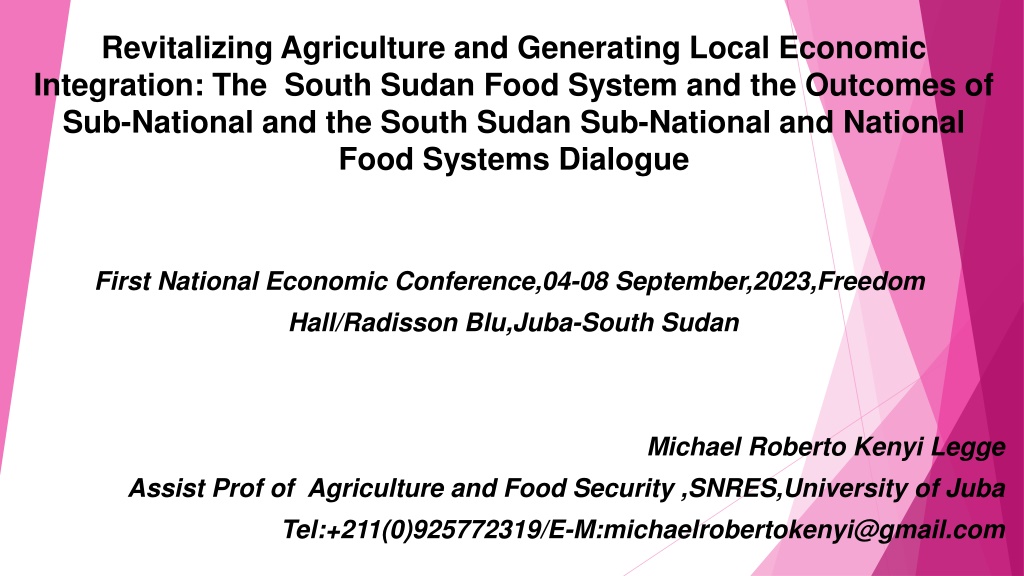
 undefined
undefined



